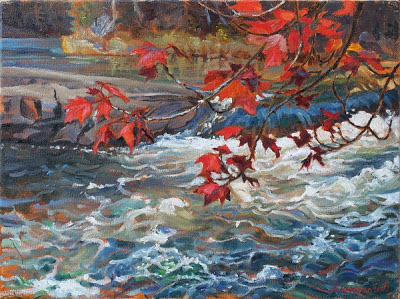Shore Birch (oil on canvas, 10 x 20 in.) Sold
7 July found me photographing shaggy Birches along the Five Fathom Hole Trail near Prince of Wales, New Brunswick, returning from the spot where I'd painted "High Lookout From the Trail", and before my view of the tributary to Butler's Creek. It was the evening of a very hot day. Mosquitoes were rising as the light was mellowing, with splashes of sunlight here and there through the forest. The air was calm. The lilting fronds of ferns were motionless, and so were the sheets of bright needles flung out into the
shadows by young Firs - but I could see rhythms of shape and colour dancing through the woods as if to music, and I wanted to capture these rhythms on canvas as if I could hear them played by an orchestra, with the curling, flourishing Birch as solo clarinet.
shadows by young Firs - but I could see rhythms of shape and colour dancing through the woods as if to music, and I wanted to capture these rhythms on canvas as if I could hear them played by an orchestra, with the curling, flourishing Birch as solo clarinet.
Both of the trees that dominate here are different from their relatives at home - this is Betula cordifolia (Mountain Paper Birch), which is also called. In Canada it grows only east of the prairies, and differs from the "ordinary" Paper Birch (B. papyrifera) in having somewhat heart-shaped leaves with minute resin dots, and pinker/bronzier bark, which breaks into finer shreds than the "ordinary" species (which also occurs on drier sites in the Musquash). It also differs in having 28 chromosomes (allowing hybridization with the oldfield Grey Birch, B. populifolia), while B. papyrifiera polyploids along with 70, 84, or 56 chromosomes (5, 6, or 4 copies of a haploid count of 14, numbers from Farrar, Trees in Canada, 1995). Owen says that farther south in the USA there is a species with even pinker/salmon-y/bronzier bark called River Birch (Betula nigra) which favours wet soils.
The Firs here are also different from those at home, Abies balsamea var. phanerolepis, the Bracted Balsam Fir, but since Fir cones disintegrate rather than falling, we can see the difference only when Fred & Owen wrench a tree down to the level where we can admire the bracted cones.
The bigger trees seem to have been left along the shore - inland it's all these smaller trees - 10-20 cm DBH. The moss and lichen make the woods look immemorially old, but as we go along the path we can see moss-covered stumps - suggesting that the moss-dominance may be a result of the failure of seeds from seed plants to reach areas which, it's been suggested, were logged in the 1990s.




Fascinating, layer by layer!
ReplyDelete